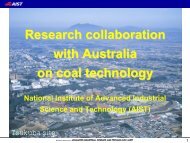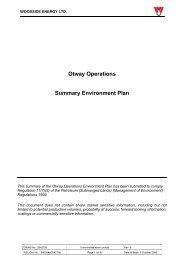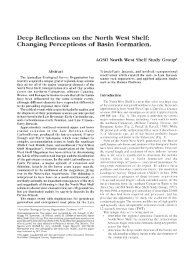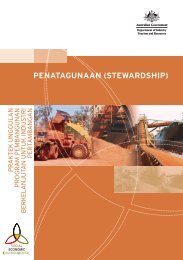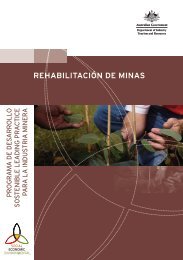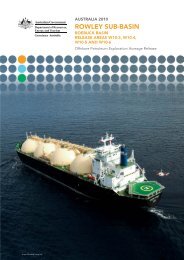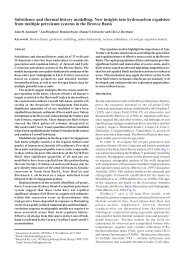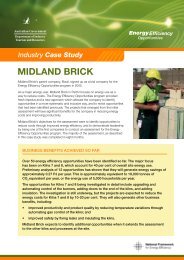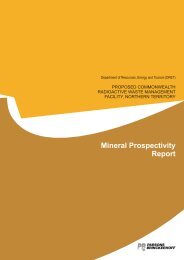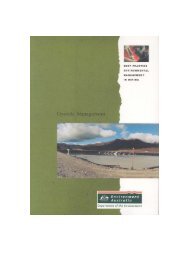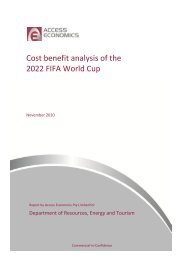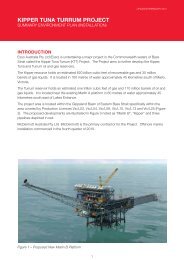A guide to leading practice sustainable development in mining
A guide to leading practice sustainable development in mining
A guide to leading practice sustainable development in mining
You also want an ePaper? Increase the reach of your titles
YUMPU automatically turns print PDFs into web optimized ePapers that Google loves.
Company policies and government regulations are <strong>in</strong>creas<strong>in</strong>gly requir<strong>in</strong>g such<br />
actions <strong>to</strong> provide better stewardship of water resources. Re-<strong>in</strong>jection requires<br />
specific geological and hydrogeological conditions with the added aim of be<strong>in</strong>g<br />
economically feasible. A re-<strong>in</strong>jection operation should be located <strong>in</strong>:<br />
geology that has the capacity <strong>to</strong> receive water at a sufficiently<br />
high rate; that is, exhibit at least moderate permeability).<br />
an area with a sufficiently deep naturally occurr<strong>in</strong>g water table.<br />
areas where the <strong>in</strong>jection quality of <strong>in</strong>jected and receiv<strong>in</strong>g waters are compatible.<br />
located with<strong>in</strong> a reasonable distance of the abstraction<br />
source <strong>to</strong> m<strong>in</strong>imise <strong>in</strong>frastructure costs, but not so close that<br />
dewater<strong>in</strong>g operations are <strong>in</strong>hibited due <strong>to</strong> recirculation.<br />
Not all these conditions may be met <strong>in</strong> all situations where it might be desirable<br />
<strong>to</strong> use re-<strong>in</strong>jection. One example where re-<strong>in</strong>jection is prov<strong>in</strong>g feasible is the<br />
Yandicoog<strong>in</strong>a iron ore m<strong>in</strong>e <strong>in</strong> the Pilbara <strong>in</strong> Western Australia. M<strong>in</strong><strong>in</strong>g commenced<br />
at Yandi <strong>in</strong> 1998. A f<strong>in</strong>es iron ore product is produced from the Channel Iron Deposit<br />
(CID) ore body. Dewater<strong>in</strong>g is required as the CID ore body is with<strong>in</strong> a significant<br />
aquifer system. It is currently standard regional <strong>practice</strong> <strong>to</strong> discharge surplus water<br />
<strong>in</strong><strong>to</strong> exist<strong>in</strong>g waterways. However, this has several associated risks <strong>in</strong>clud<strong>in</strong>g the<br />
potential <strong>to</strong> develop dependent riparian ecosystems on the year-round water supply,<br />
<strong>in</strong> the process los<strong>in</strong>g their adaptation <strong>to</strong> ephemeral wet season flows. In addition,<br />
this discharge may be considered wasteful by other stakeholders, particularly <strong>in</strong> the<br />
dry Pilbara region. Aquifer re-<strong>in</strong>jection allows a component of the water extracted <strong>to</strong><br />
be returned <strong>to</strong> the environment, limits impact on downstream surface ecosystems,<br />
m<strong>in</strong>imises potential discharge impacts on the surround<strong>in</strong>g environment, and<br />
preserves a valuable resource that may be s<strong>to</strong>red and withdrawn <strong>in</strong> the future. It is<br />
important <strong>to</strong> recognise that although re-<strong>in</strong>jection has been successfully implemented<br />
at Yandi, the application of this technology is dependent upon several fac<strong>to</strong>rs, <strong>in</strong><br />
particular, the site-specific hydrogeological conditions. Re-<strong>in</strong>jection should not be<br />
considered the ’silver bullet’ for deal<strong>in</strong>g with all excess water management situations.<br />
For those operations where it is appropriate, aquifer re-<strong>in</strong>jection can be a powerful<br />
<strong>to</strong>ol for the m<strong>in</strong><strong>in</strong>g community <strong>to</strong> utilise <strong>in</strong> order <strong>to</strong> preserve the groundwater<br />
resource and riparian ecosystem <strong>in</strong>tegrity (see LP Water p.79).<br />
128 LEADING PRACTICE SUSTAINABLE DEVELOPMENT PROGRAM FOR THE MINING INDUSTRY



